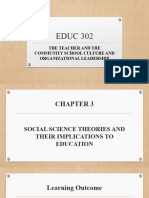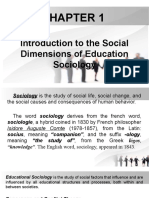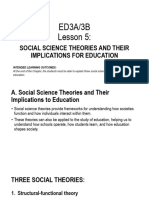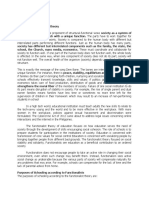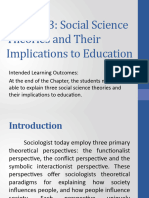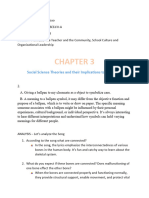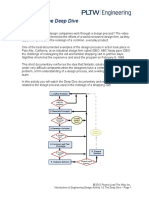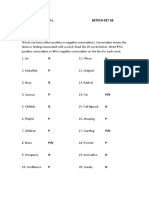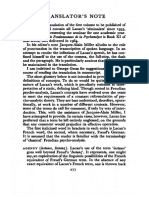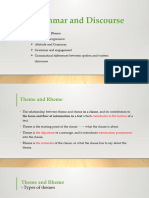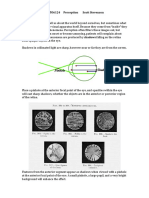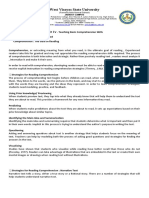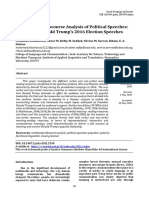The Teacher and the Community, School Culture, and Organizational
Leadership
EDUC 107
The Teacher and the
Community, School Culture,
and Organizational Leadership
DIONISIO M. UYCHOCO
2ndt Sem 2024-2025
Module 3
Society and Education
1. Lesson 1 Social Dimensions of Education
Topic 1 Consensus and Conflict Theories
Topic 2 Functionalism
Topic 3 Interactionist Theories
2. Lesson 2 Schools and Social Institutions: Family; Education;
Religion;
Economic Institutions; Government
3. Lesson 3 Education 4.0: Responding to the demands of Society
INTRODUCTION
Society and education are inseparable. Societies host educational
institutions which are in turn responsible in maintaining a just, humane, and
civilized society.
Social Science theories offer us a lens through which we see and
examine society. Conversely, society provides a fair and reliable groundwork
for any reforms in education.
MODULE 3 presents and discusses at least three (3) Social Science
Theories – Conflict and Consensus Theory, Structural Functionalist
Theory, and the Interactionist Theory – how each exerts influence on the
teacher, the school, and the community and explains the implication of each
in a dynamic education system.
1
� The Teacher and the Community, School Culture, and Organizational
Leadership
OBJECTIVES
When you are done with this MODULE, you are expected to be able to:
1. show understanding of the nature of schools, the community,
and school culture;
2. describe an ideal teacher – school – community relationship;
3. show understanding of the implications of social science theories to
education.
Task 1.
Activity A. Directions. Read the following text then do the Tasks
required of you to accomplish.
Education and Society
Education and schooling are found within the context of society.
Schools exist within social context and any change within schools in terms of
educational aims, goals, and objectives including its contents are always in
relation to societal changes. Society and schools are interdependent and
provide bidirectional influence to each other. Sociology as a science provides
theories, concepts and principles that help us better understand theories and
principles that help shape and guide education. Education on the other hand
through its curriculum trains and educate the people with the necessary
knowledge, skills, values and attitudes that are necessary for its continued
maintenance, growth and development.
Social Science Theories
Three Social Science Theories that provide models of examining
society which in turn provides the bases for educational changes.
Topic 1 Consensus and Conflict Theory
Topic 2 Structural Functionalism
Topic 3 Symbolic Interactionism
2
� The Teacher and the Community, School Culture, and Organizational
Leadership
Interactionist Theory
Interactionist Theories attempt to make the commonplace, strange
by noticing, focusing their attention and observing the everyday-taken-for-
granted behaviors and interactions between students and students, and
between teachers and students. It is what conflict and functionalist theories
do not notice, do not focus their attention to, do not question that is most
problematic to the interactionists.
Symbolic Interactionism
Interactionist Theory is traced back to the works of sociologists
George Herbert Mead and Charles Horton Cooley. They examined the ways
in which the individual is related to society through ongoing social
interactions.
This school of thought, known as Social Interactionism, views the
self as socially constructed in relation to social forces and
structures and the product of ongoing negotiations of meanings.
Thus, the social self is an active product of human agency rather than
a deterministic product of social structure. The social self is a result of
social interaction mediated by symbols, in particular, language. The
distinctive attributes of human behavior is viewed as the result of
individuals’ participation in varying types of social structures which in turn is
dependent on the existence of language behavior.
Symbolic Interactionism is not only interested in socialization but
also in interaction. Interaction is significant in terms of (a) development
of one’s ability to think, and (b) development of one’s ability to
express what s/he thinks. All types of interaction, not just interaction
during socialization, refine our ability to think which in turn shapes the
interaction process.
However, not all forms of social interactions require mental processing
or will involve our ability to think. They are NonSymbolic Interaction or in the
term used by George Herbert Mead, the conversation of gestures which does
not involve thinking. Blumer made the differentiation between those two
basic forms of social interaction, namely (1) non-symbolic interaction
which does not involve thinking, and (2) symbolic interaction which
require mental processing, (Vega, et al. 2015, p.11).
3
� The Teacher and the Community, School Culture, and Organizational
Leadership
Principles of Symbolic Interactionism
1. Human beings, unlike lower animals, are endowed with a capacity
for thought.
2. The capacity for thought is shaped by social interaction.
3. In social interaction, people learn the meanings and symbols that
allow them
to exercise their distinct capacity for human thought.
4. Meanings and symbols allow people to carry on distinctively human
action
and interaction.
5. People are able to modify or alter the meanings and symbols they
use in
action and interaction on the basis of their interpretation of the
situation.
6. People are able to make these modifications and alterations,
because, in
part, of their ability to interact with themselves, which allows
them to examine possible courses of action, assess their relative
advantages and disadvantages, and then choose one.
7. The intertwined patterns of actions and interactions make up
groups and
societies.
Symbolic Interactionism is based on the following premises (Mead)
1. People act toward the things they encounter on the basis of what
those things mean to them. The word things refer not only to objects
but to people, activities, and situations as well.
2. We learn what things are by observing how other people respond to
them through social interaction.
3. As a result of ongoing interaction, the sounds (or words), gestures,
facial expressions, and body postures we use in dealing with others
acquire symbolic meanings that are shared by people who belong to
the same culture.
Example: The handshake, a symbolic gesture which is not simply a
mutual grasping of hands, palms, fingers but conveys the symbolic
gesture of greetings among Filipinos. The importance of thinking
to symbolic interactionists is reflected in their views on objects.
According to Blumer, there are three types of objects:
1. Physical objects – chair, tree, Vans shoes
2. Social objects – student, mother, boyfriend, girlfriend
3. Abstract objects – such as ideas or moral principles (All
human beings are created by God and therefore everybody must
4
� The Teacher and the Community, School Culture, and Organizational
Leadership
be given equal rights and must be treated with respect and
dignity.)
Objects are seen simply as out there in the real word. What is
important is the way they are defined or interpreted by the individuals
experiencing those objects. Such interpretations lead to a relativistic view
that objects may have different meanings for different individuals.
Example: To a shoemaker, a shoe may mean his source of livelihood
or an expression of his artistic talent; a shoe for a poor kid may be a source
of frustration for not owning a pair; a shoe for a teenager may be a source of
pride, a status symbol.
Related to the idea of the self as a social construct is the concept of
the looking glass self put forward by early symbolic interactionist theorist,
Charles Horton Cooley. The concept of the looking glass self suggests
that we come to develop an understanding of who we are and who
we are not, a self-definition, on the basis of the words or actions of
others towards us. The looking glass self forwards the idea that “We see
ourselves as others see us”. A student may acquire the idea that s/he is
smart or dumb, likeable or unlikeable, pretty or ugly from what others tell
him/her; or how others make him/her feel about himself/herself. Cooley
explained that we use other people as a mirror into which we look to see
what we are like, (Farley in Vega, et al., 2015, p.12).
Implications to Teaching
1. Teach for meaning. Promote and create opportunities for genuine
interaction among our students, teachers, between students and
teachers. Interaction includes reading, listening, viewing. Views and
meanings are conveyed in what people write and talk about in
speeches and lectures they deliver.
2. Use positive symbols (gestures, words, actions, and appearances) to
express our trust, belief in our students’ abilities, an affirmation of their
being. Our belief in our students also has positive effect in us. We find
ourselves more prepared in class, more caring, truly professional.
Task 2. Look into the major points.
Activity 1. State briefly how the Symbolic Interactionist Theory
view of ‘self’.
________________________________________________________________________
________________________________________________________________________
5
� The Teacher and the Community, School Culture, and Organizational
Leadership
________________________________________________________________________
________________________________________________________
Activity 2. Complete the diagram below in order to encapsulate the
concept of
the ‘social self’. One of the components is already given.
Social
Self
Task 3. Look into the details
Activity 1. ‘Symbolic Interactionism’ is both
a. ______________________________
b. ______________________________
Activity 2. Based on the text you have read, ‘Interaction’
has two important requisite abilities; these are:
a. ______________________________
b. ______________________________
Activity 3. ‘Social Interactions’ may be of two (2) kinds:
a. ______________________________
b. ______________________________
6
� The Teacher and the Community, School Culture, and Organizational
Leadership
Task 4. Find some application
The concept of the looking glass self suggests that we
come to develop an understanding of who we are and
who we are not, . . . on the basis of the words or actions
of others towards us. The ‘looking glass’ means that “We
see ourselves as others see us” . In simple terms, “we are
what other people think about us”.
Using the above proposition, answer the following
questions:
1. Students sometimes judge their teachers more by their
actions than by their words. With this, how should teachers
conduct themselves in and out of the classroom?
__________________________________________________________________
__________________________________________________________________
__________________________________________________________________
__________________________________________________________________
__________________________________________________________________
__________________________________________________________________
__________________________________________________________________
__________________________________
2. There are instances when teachers are misinterpreted by their
students? Is this all right? Tell us more.
Task 5. Give your insights.
DMMMSU is part of a community and a larger society. As a
student, what do you think of this university based on what you
observe it is doing to you at present. Limit your answer to 5
sentences only.
____________________________________________________________
__________________________________________________________________
__________________________________________________________________
__________________________________________________________________
7
� The Teacher and the Community, School Culture, and Organizational
Leadership
__________________________________________________________________
__________________________________________________________________
__________________________________________________________________
__________________________________________________________________
__________________________________________________________________
__________________________________________________________________
_______________________
Part 3 of Module 3 ends here.
Social structure describes the way in which society is organized
into predictable relationships and patterns of social interaction
(the way in which people respond to each other). These patterns
are to some extent independent of the particular individual, as
they exert a force that shapes individual behavior and the
identity of the society.
Society uses norms to control acceptable methods of achieving
culturally approved values (e.g. wealth). When these norms and
values come into conflict, the social and regulatory structures
become strained, and the result is either social change or a
breakdown in the functioning of the social structure.
Social structure refers to the pattern of social relationships in a society.
Such structure regulates the interactions among members of the society,
providing guidelines within the cultural norms for achieving the goals defined
by cultural values. Generally, social structure maintains societal stability.
However, when the social structure and the societal values become
incompatible, the structure must embrace social change to allow the society
8
� The Teacher and the Community, School Culture, and Organizational
Leadership
to survive and continue healthy development. While a variety
of sociological approaches have sought to describe the development and
maintenance of social structure, understanding the relationship between
structure and change is necessary for the development of a peaceful world
society.





